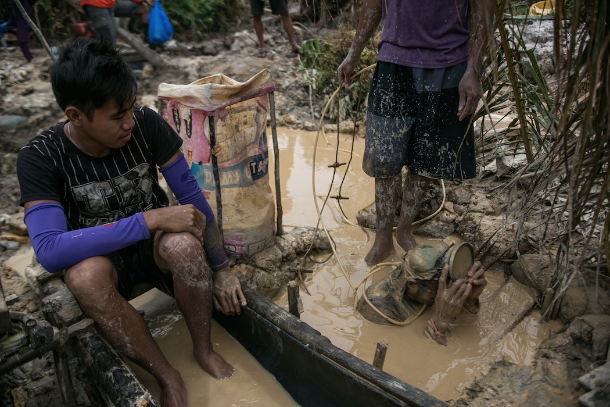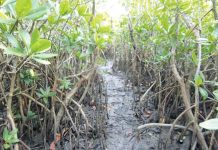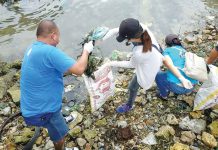
ARTISANAL mining – better known as small-scale mining in the Philippines – has become synonymous with danger. The methods of extraction do not only threaten people’s health and the environment but in some cases result in disasters.
For a family in the small town of Paracale in the southern province of Camarines Norte, the search for gold has become, however, second nature. Family members claim it’s the safest task that they perform day in and day out.
The perfect time for them to go prospecting is when the tide is at its lowest and the sun is hidden behind the clouds.
Gemma Badurya, a 40-year-old mother of three, orchestrates the “game” with the children who with their shovels dig shallow pits in the sand that are easily filled with seawater.
Gemma pours water on the hakawan, a wooden devise that separates the gold from the sand, next to the children. Her husband, Rudy, fills the devise with sand using a bucket.
The children watch as sand passes through the various layers of the device, a process that is repeated over and over again.
“We are extracting gold particles,” Gemma explained. “Gold is heavier than the sand so it falls into the tiny spaces.”
She added that they only search for gold when the wind blows from the northeast and when the waves are high. Her husband is a fisherman, and huge waves that come with the northeast monsoon winds prevent the fishermen going to sea.
“This is the most dangerous month of the year for us,” said Rudy. “We can fish but only if we use big boats that we, poor fishermen, don’t have.”
About ten years ago, a friend introduced Rudy to searching for gold on the seashore. From then on, the fisherman was hooked.
“I only do it when nature decides to share the gold,” he said.
Rudy and his family spend five hours every day by the shore during low tide for two months when fishing is next to impossible because of the weather.
He said the search for gold is “relatively easier” than fishing. But he admitted that he cannot abandon his nets and dig the seashore every day of the year.
“I have to feed my family,” he said. “The money from gold cannot buy food if there are no fishermen to catch fish,” said Rudy.
He said gold particles can only be found during the months of November and December.
Al Cababay, a native of Paracale, said the gold comes from the river that flows from the mountains to the sea. Strong waves wash the gold particles on the shore during the monsoon season.
Mining in Paracale town, which has a population of about 65,000, dates back many years to 1626 when gold was struck in Camarines Norte province.
Historians noted that the town’s name is derived from para cale, which is supposed to mean “canal digger.”
While gold panning has become the most popular method of extraction, the townspeople of Paracale have ventured into “underwater gold mining” with the use of air compressors.
Miners make holes in rivers and swamps, and even rice paddies, that can fit a person.
The miner then dives into the muddy hole with only the compressor as a source of air. He digs underwater for as long as three to four hours before resurfacing to check the soil samples for gold.
The miners dig up to eight meters until they reach a layer where there is gold ore. The hole is reinforced with wood or tree branches to prevent it from collapsing.
There have been incidents in the past where miners have died in the pits. Some were trapped, while others were starved of oxygen.
But people have been silent about these incidents. So-called compressor mining has been declared illegal, so miners do what they describe as a “guerrilla type” of mining.
Father Rodello Rempillo, parish priest of the town, said he is against activities that destroy the environment and put lives in danger, “but what would you do if it were the only source of livelihood for someone?”
For Rudy the fisherman, the only way to survive the huge waves in monsoon season is to “harvest the fruits of the waves that come to shore.”
“I think that’s how nature works. It will give you the things you need. You just have to wait for it,” he said. (UCA News/PN)



